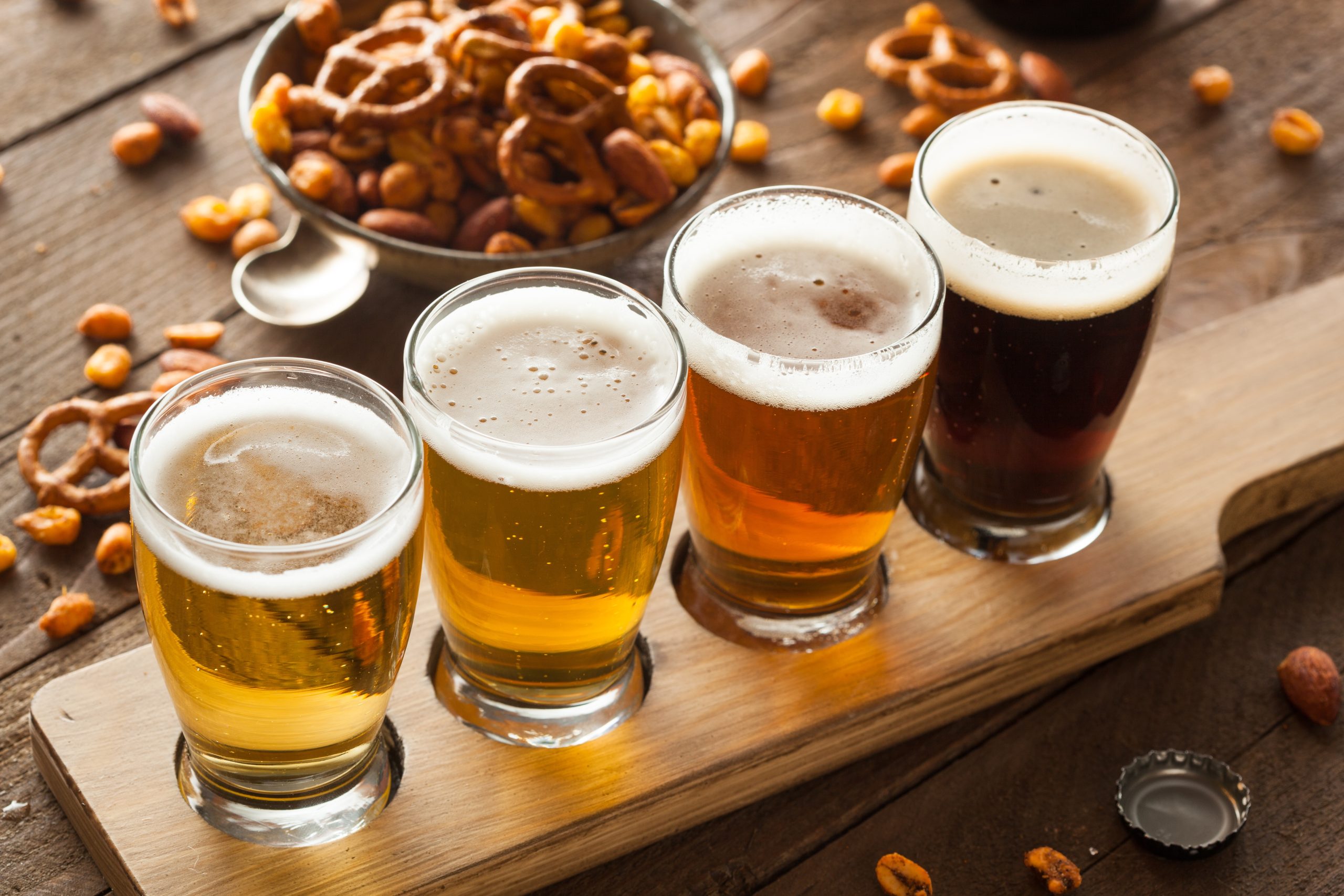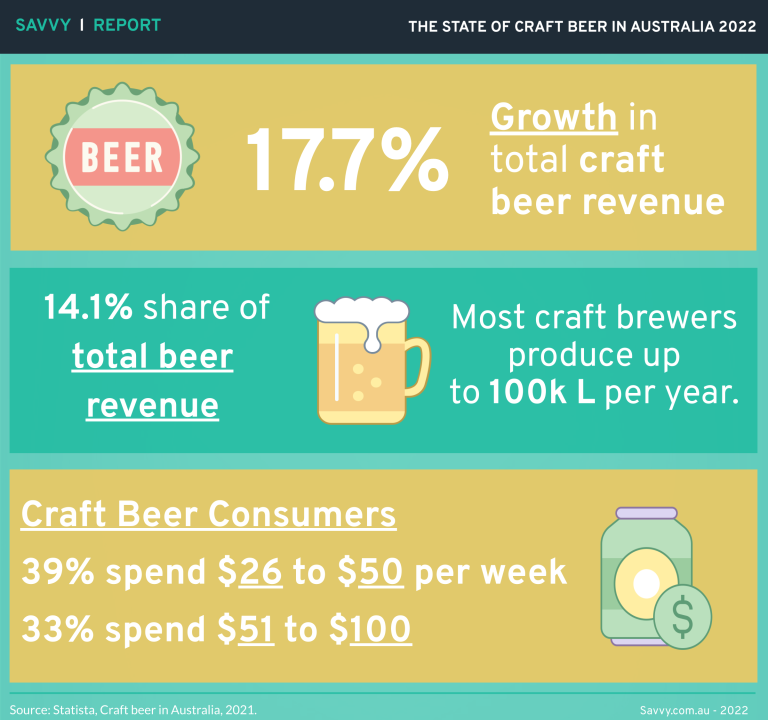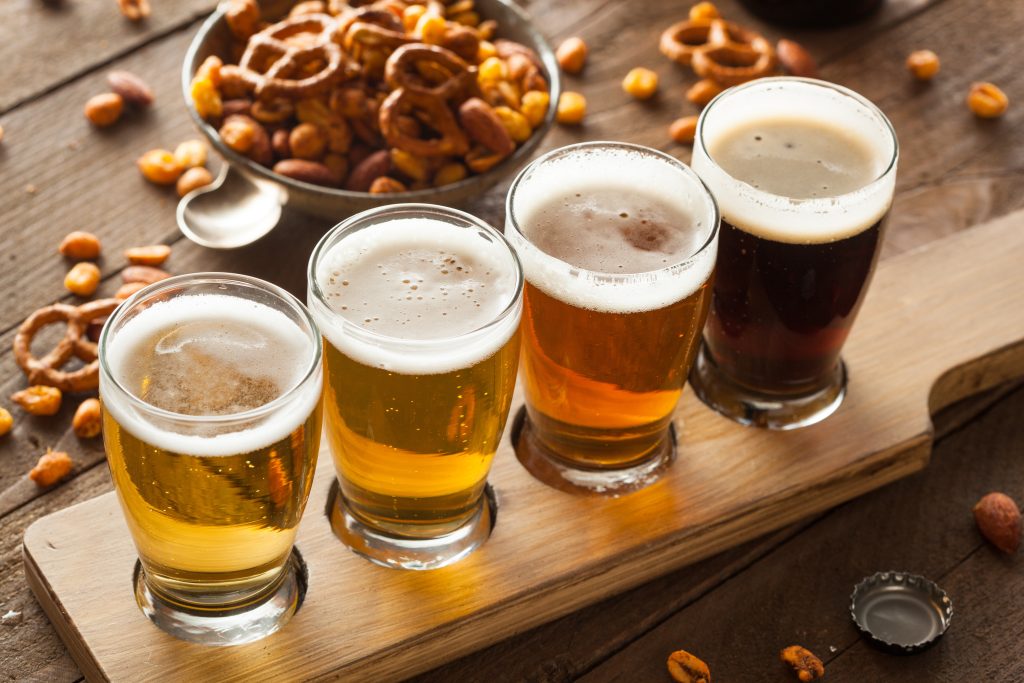
- The Savvy Promise
At Savvy, our mission is to empower you to make informed financial choices. While we maintain stringent editorial standards, this article may include mentions of products offered by our partners. Here’s how we generate income.
In this article
The craft beer industry in Australia has been going from strength to strength over the past two years, as microbreweries capture a modest but ever-increasing portion of the overall beer market. Savvy's investigation sheds light on the figures.
- 17.7% growth in total craft beer revenue
- 14.1% share of total beer revenue held by craft breweries
- Most brewers produce up to 100,000 litres per year
- 39% of consumers spend $26-$50 per week & 33% spend up to $100
It was inevitable – Australians and their love of beer would reach even greater heights of quality, flavour, and daring. This all culminated in the advent of the “microbrewery” – Australians making their own small batch beers using wild and wonderful flavours: cherry sours, New England India Pale Ales, XPAs, chocolate stouts – the list goes on!
However, many microbrewers found fame – and fortune – opening their own small batch breweries that expanded into full-scale operations. Once niche backyard hobbies became profitable businesses. Some breweries offer tap rooms, meals, entertainment; some are centred around providing fine dining gastropub fare.
Like all offshoots of the hospitality industry, the craft beer industry was equally affected during the COVID-19 pandemic; hospitality was often the first to close and the last to open (even at full capacity) during any lockdown announcement. Though lovers of craft beer could still order their favourite bottles or cans online or at retailers, what effect did it have on the industry as a whole? Was there a big dip in craft beer production? How does it compare to the wine industry? Where are the craft breweries in Australia, and what lies ahead for the industry as a whole?

Overview of beer production in Australia
According to a report by Statista titled Craft Beer in Australia, Australia is the far away leader in beer production in the Oceania region, producing 16,580 thousand hectolitres (1000 x 100L) in 2020. Compare this to New Zealand, producing 2,930 thousand hectolitres.
The total direct economic contribution from beer production was $4.6 billion nationally in 2018; Queensland was the state with the highest contribution at $1.76 billion.
Growth of the independent brewery
The independent craft brewery industry has seen steady growth according to a recent report by Independent Brewing Australia, experiencing a 17.7% growth in revenue from 2019 to 2020 and increasing its share of total beer revenue by 14.1%. A majority of brewers produce 1 to 100,000 litres per year, with the next biggest group producing between 100,000 and 700,000 litres.
Beer sales in pubs and clubs hit hard during COVID-19 pandemic
According to the Alcohol Beverages Australia association, 441,400 jobs were lost in the hospitality industry over 2020-2021, following $8.5 billion in lost sales – or 10% of their annual sales. This represented a third (33.4%) of the entire hospitality workforce. Beer volumes fell by 44%, with smaller producers (usually, but not always, craft brewers) reporting volume losses of over 70%. Major beer, wine and spirits companies experienced a 15.5% workforce decline in April of 2020. The report also showed that after the “panic” phase of the pandemic passed after April/May of 2020, the short uptick in “stocking the cabinet” (21.4%) was followed by a slump (2.9%).
According to the Australian Bureau of Statistics, four in five (85.6%) Australians were drinking responsibly during the lockdowns or extended restrictions. Smaller producers, usually reliant on tourists or local patrons, were hit particularly hard. Some distillers – that produce grain alcohol – pivoted toward selling hand sanitiser. Breweries that have no capacity for distillation could not do so.
Are Aussies drinking less beer than previous generations?
In 2018, the average alcohol consumption of an Australian adult was three standard drinks or eight standard drinks over the course of a week, according to the Australian Bureau of Statistics. In terms of beer consumption in terms of litres, that means 3.71 litres of beer per capita. Contrast this to our parents’ generation, where peak consumption occurred in 1973 with a staggering 9.18 litres of beer consumed per capita.
The rise in consumption may be partially explained by increased excise on spirits during the 1960s and 70s and a decline of locally distilled spirits due to trade liberalisation. The end of the 1960s also spelled the abolition of the “six o’clock swill” in which pubs and bars were forced to close at 6pm. The “swill” meant workers had only one hour (minus travel time) to consume as much beer as possible before the bar closed. Once abolished, this allowed patrons to drink greater quantities over a longer period of time. Excise on alcohol has also increased over time, as has the price of beer – the retail price index of alcoholic beverages was 14.1% higher in 2019 compared to 2012.
In terms of per capita consumption per year in litres, Australians consumed 4.41 litres of light (low alcohol) beer, 18.75 litres of mid-strength beer, and 64.4 litres of full-strength beer during the financial year ending 2018.
Average Weekly Spend on Beer in Australia (2020)
No Data Found
Source: Statista, Craft Beer in Australia, pg. 14. (Survey of 17,000 craft beer drinkers)
Number of jobs in the brewing industry in Australia in financial year 2018, by employer type (in 1,000s)
No Data Found
Source: Statista, Craft Beer in Australia, pg. 11
Where are the breweries?
According to the latest on the ground research by Brews News, most independent breweries are in Victoria, with 158 breweries. This is followed by New South Wales, on 127, Queensland on 88, and Western Australia on 75. South Australia boasts 49 and Tasmania 24, while the NT has 5 and the ACT 4.
Who is drinking craft beer in Australia?
According to Statista, the distribution of craft beer drinkers closely follows the population distribution of Australia – most drinkers are found on the Eastern Seaboard and scattered throughout the other less populous states.
However, your average craft beer drinker will likely be a (bearded) male between the age of 30-39 years of age – 79% of men are craft beer drinkers compared to 21% of women; with 39% of 30-39s and 26% of 40-49s taking up the lion’s share of craft beer drinking.
Most craft beer drinkers have been doing so for at least 3-5 years (30%) with 26% saying they’ve been drinking for 11 years or more. This indicates that craft beer is far from a fad, with only 2% saying they’ve taken to the drop for less than a year.
Number of independent breweries in Australia as of February 2022, by state and territory
No Data Found
Source: Brews News, brewery database, 2022.
Post-swillonomics – the economics of craft beer in Australia
The market share of non-major breweries in Australia are split between the premium, mainstream, and discount markets. According to market research by Asahi compiled by Statista, in the premium market, non-majors account for a 35% market share. In the mainstream, non-majors take up 14% – no small feat since the market is dominated by Asahi (51%), who owns Carleton United Breweries and Kirin group (35%), who owns Lion Nathan breweries. Craft breweries only take up 1% of the discount market – considering craft brewing is a premium product, this isn’t an anomaly.
The average weekly spend on beer in Australia is clustered in the $26-$50 range (39%) and the $51-$100 range (33%).
As for the leading beer styles, a Statista survey of 17,000 craft beer drinkers showed that 88% of respondents preferred Pale Ale or XPA (extra pale ale) followed by India Pale Ale or double IPA (IIPA) at 84%. New England IPA was next at 65%, Amber or red ale at 63%, and Stout or imperial stout at 61%.
Sour beers were the least favoured, though commanded a respectable 48% preference.
As for the changes in how often craft beer drinkers buy their hoppy concoctions, most preferred to buy online – online sales saw an 18% increase during the COVID-19 panic period (April-May 2020) while takeaways from breweries saw a 4% increase.
Most quaffers of craft beer buy weekly from mainstream liquor stores, with around 80-85% preferring to buy from those outlets. Similar proportions of people buy with the same frequency – roughly the same numbers buy weekly, fortnightly, or monthly. Just under 70% buy from specialist retailers, 60% from craft breweries direct, and a shade under 40% buy online. Most people who buy online order only every two to three months. It would seem the more convenient the outlet, the more craft beer buyers buy, on average. As for how much they buy, 68% purchase six-packs the most; followed by slabs of 24 (54%). The humble four-pack is left at the bottom on 38%, using data from a Beer Cartel survey via Statista.
As for delivery services, which became extremely popular during the pandemic, 31% of those who used alcohol delivery because it was more convenient; 26% said it was cheaper to buy in bulk online; 25% said it was better value for money. 11% said they used the service to avoid driving while intoxicated.
As for who makes the beer, small (non-major) brewers account for 1,240 jobs in manufacturing and 1,150 jobs in retail and venues.
The eternal debate: can vs bottle
Far from conclusive, the can vs. bottle argument shows that cans are only slightly more preferred (38%) over bottles (27%) while about a third of beer drinkers (35%) are content to sit on the fence – as long as the beer is cold, and the vibe is good!
Did you find this page helpful?
Author
Adrian EdlingtonPublished on February 21st, 2022
Last updated on March 18th, 2024
Fact checked
This guide provides general information and does not consider your individual needs, finances or objectives. We do not make any recommendation or suggestion about which product is best for you based on your specific situation and we do not compare all companies in the market, or all products offered by all companies. It’s always important to consider whether professional financial, legal or taxation advice is appropriate for you before choosing or purchasing a financial product.
The content on our website is produced by experts in the field of finance and reviewed as part of our editorial guidelines. We endeavour to keep all information across our site updated with accurate information.











